sustainable use of biological diversity.pdf - India Environment Portal
sustainable use of biological diversity.pdf - India Environment Portal
sustainable use of biological diversity.pdf - India Environment Portal
You also want an ePaper? Increase the reach of your titles
YUMPU automatically turns print PDFs into web optimized ePapers that Google loves.
Sustainable <strong>use</strong> <strong>of</strong> <strong>biological</strong> <strong>diversity</strong> in socio-ecological production landscapes<br />
are composed <strong>of</strong> women, and hence the term ‘women’s<br />
groups’. The main activities in recent times include<br />
tree planting, soil erosion control activities and<br />
income generating activities. Group members meet<br />
about once in a week. A typical group has about 20-<br />
30 members. Most women belong to such groups.<br />
4.8.6 Threats to local species and local knowledge<br />
Many <strong>of</strong> local natural fruit trees are threatened by<br />
short-term needs <strong>of</strong> some ho<strong>use</strong>holds who cut them<br />
for charcoal or timber, usually for sale to buy food<br />
in times <strong>of</strong> food shortage. The associated indigenous<br />
knowledge is also threatened, as much <strong>of</strong> it is lost<br />
together with the loss <strong>of</strong> the species.<br />
5. conclusion<br />
Kitui’s diverse mosaic landscape provides a fertile<br />
ground for innovation and adaptation to growing<br />
uncertainty. The Kitui agrarian landscape has six<br />
ecozones; they contain two types <strong>of</strong> gardens, crop<br />
fields, forest groves, pastures, forests flood plains and<br />
water harvesting sites. Together, they are managed as<br />
part <strong>of</strong> a single agricultural system that maximises<br />
bio<strong>diversity</strong> to produce food from wild and cropped<br />
areas, as well as domestic and wild animals. This has<br />
allowed people to cope with increasing risks to field<br />
crops such as maize. Continuing domestication and<br />
increased cultivation <strong>of</strong> indigenous food plants such<br />
as gourds, pigeon peas, and trees are yielding new<br />
products with growing market potential.<br />
Local institutions have proved to be essential in<br />
the coping strategies and management <strong>of</strong> Kitui’s<br />
mosaic landscape. Collective work groups and self<br />
help groups combine both traditional forms <strong>of</strong> collective<br />
labour and land management as well as new<br />
groupings to tap into new technologies and knowledge.<br />
The experience <strong>of</strong> Kitui is evidence <strong>of</strong> the need<br />
to support knowledge-intensive agriculture in biodiverse<br />
landscapes as a way to cope with environmental<br />
change and uncertainty. Local knowledge<br />
is acquired and maintained by institutions that are<br />
deeply embedded in local culture and are governed<br />
by customary rules as well as formal organisational<br />
rules that are derived from community development<br />
a member <strong>of</strong> Kyanika adult Women’s group working in a<br />
group farm. The crop is an early maturing pigeon pea.<br />
models. The importance <strong>of</strong> local and traditional<br />
knowledge is growing and well recognised within<br />
the community. It includes indigenous knowledge<br />
passed down from earlier generations to ethnobotanical<br />
and agronomic knowledge obtained through<br />
linkages with outside institutions. The entry point<br />
for interaction with outsiders remains the indigenous<br />
customs and knowledge held by senior Kitui<br />
women and men. A key feature <strong>of</strong> the maintenance<br />
and rise <strong>of</strong> local institutions for managing agroecosystems<br />
is the lead role played by women.<br />
further reading<br />
Johns, T., Smith, I.F, and Eyzaguirre, P. 2006. Understanding the<br />
Links Between Agriculture and Health. Agrobiodiversty, Nutrition,<br />
and Health. Focus 13 Brief 12 <strong>of</strong> 16 May 2006. IFPRI<br />
Oduol, W. (1995) “Adaptive Responses to Modern Technology:<br />
Kitui Farmers in the Semiarid Regions <strong>of</strong> Eastern Kenya in Technology<br />
Policy and Practice in Africa edited by O.M. Ogbu, B.O.<br />
Oyeyinka, and H.M. Mlawa, IDRC, Ottawa. 1995<br />
Opere A.O., V.O. Awuor, S.O. Kooke and W.O. Omoto. 2002.<br />
Impact <strong>of</strong> Rainfall Variability on Water Resources Management:<br />
Case Study in Kitui District, Kenya WaterNet/Warfsa Symposium<br />
‘Water Demand Management for Sustainable Development’, Dar<br />
es Salaam, 30-31 October 2002<br />
Shackleton, C.M., Pasquini, M.W., and Drescher A.W. 2009. African<br />
Indigenous Vegetables in Urban Agriculture. Earthscan.<br />
Thrupp L.A. 2000. Linking agricultural bio<strong>diversity</strong> and food security:<br />
the valuable role <strong>of</strong> agrobio<strong>diversity</strong> for <strong>sustainable</strong> agriculture.<br />
International Affairs 76 (2): 265–281.<br />
© P. Maundu<br />
72
















